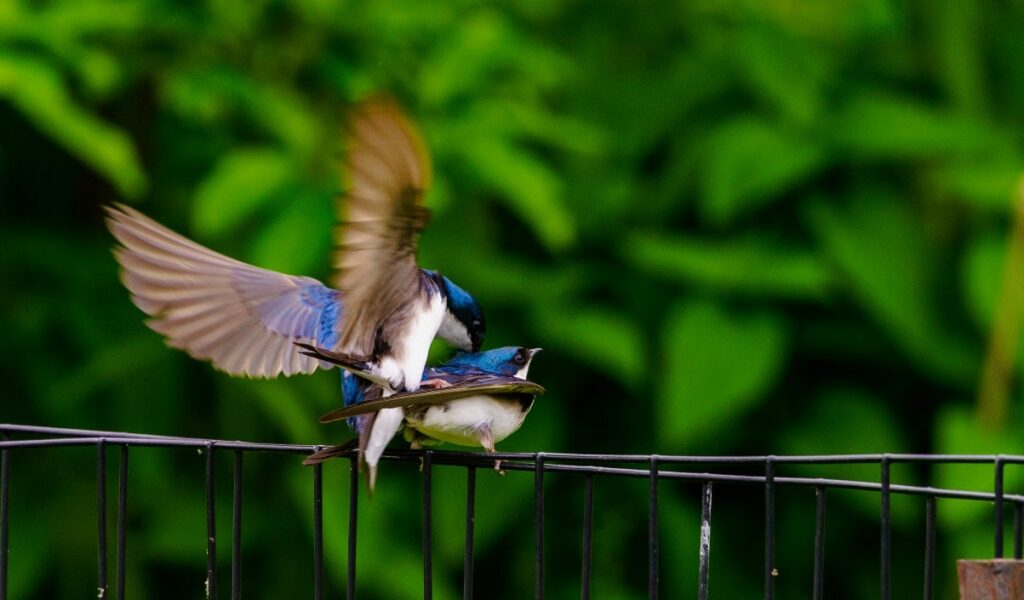Many species of birds are monogamous, staying with one mate their entire lives. Bluejays are social birds that are typically found in big groups. Do these beautiful birds choose a mate for life?
Bluejays do mate for life. When the bird has chosen its partner, it will have a bond that lasts its entire life. Bluejays go through a unique mating ritual to find the right partner. When they do, the birds stay together and raise chicks during the breeding season.
The relationship Bluejays have with one another is fascinating. To show their love for each other, Bluejays will continuously give gifts (like food and nest material) to their partner. Once these birds find their partner, they are known to stay in the same residential area together instead of migrating.
How Do Bluejays Choose A Mate?
Bluejays have a very interesting ritual for choosing a mate. It’s very similar to a dating show contest. When a female is ready to find her mate, she will fly around the area to attract the attention of the males.
The males in the area will then make calls as they follow after her. Approximately 6 to 10 male Bluejays will attempt to win her courtship.
The female will choose a tree to land on. The males will follow her, landing on the same tree. They will then take turns bobbing their heads and whistling. This is a very unique process because the female won’t signal for any of the males to leave.
Instead, the male birds will eliminate themselves from the courtship competition of their own will. When they’re no longer interested, they will fly away.
When it’s down to the last male bird, he will be the female’s partner. The two birds will show their commitment to one another by giving each other a gift and then ruffling their feathers towards each other.

When Do Bluejays Mate? (What Time Of The Year?)
Bluejays are usually ready to mate once they are a year old. They typically start looking for a mate any time from the late winter months through early spring.
After they have found a mate, Bluejays go through a nesting process. This is when they pick out several locations and build test nests. During this process, the male finds the building materials. The female will inspect the piece, choosing the best materials to work with.
Once the birds have made a few test nests, they will be ready to build their real nest. This typically happens between March and July. The birds will be able to start breeding once their nest is complete. Peak breeding season is in April and May.
How Do Bluejays Mate?
Bluejays will raise their chicks together. Once their nest is finished, they will be ready to start mating. This is done by the male rubbing his cloaca on the female. He will do this in order to transfer sperm to her.
After a few weeks, the female will lay approximately 3 to 9 eggs. These eggs will take anywhere from 14 to 19 days to hatch. During this time, the female will stay sitting on them to keep the eggs incubated. The male will feed her and keep guard of their area.
Both the male and female Bluejays will be protective of the chicks when they hatch. The chicks will remain in the nest for at least 2 months. Throughout this time, the male and female will share the duties of feeding and keeping the chicks safe. The chicks will also stay with them for a period of time after they’re ready to leave the nest.
How Often Do Bluejays Mate?
Bluejays can mate several times throughout their lives. It’s common for Bluejays to mate every breeding season. Since the breeding process doesn’t take long, some Bluejays breed twice a season.
This means that a pair of bonded Bluejays could produce a lot of offspring throughout the years. The average lifespan of these birds is 7 years. However, some of them can live a lot longer than that. The oldest wild Bluejay recorded was over 17 years old. That’s a lot of breeding seasons for these birds.
What Happens If Bluejay Loses Its Mate?
Bluejays treat their bonds as a business in a way. When one bird’s mate dies, the living mate doesn’t go through a mourning period. This has been determined by researchers that found no evidence to support a grieving period.
Instead, the bird seeks a new mate and carries on with its life. They will then bond with their new partner for life. These birds aren’t known to stray. Bluejays will never leave a living partner to find a new mate.
As long as both birds are alive, they will remain together. However, these birds are social and don’t like to be alone. That is why they are quick to find a new partner once their partner has passed on.
